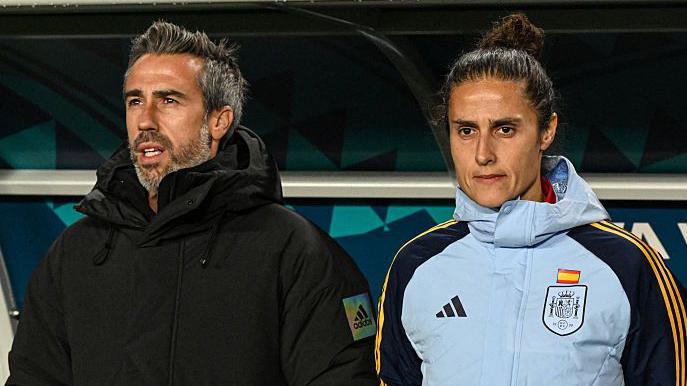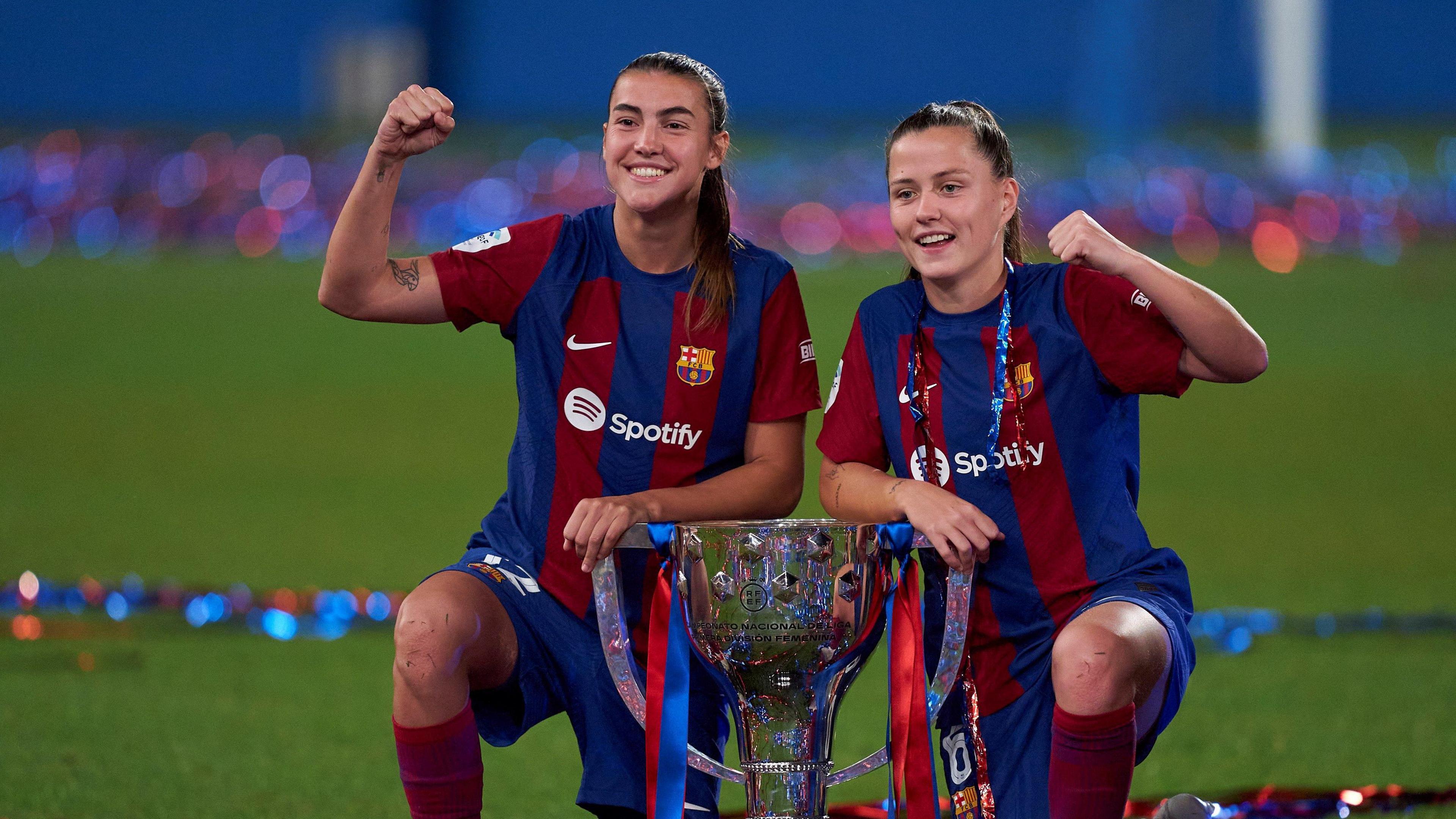Boycotts, protests and even a hunger strike. These are not events normally associated with the aftermath of winning a World Cup.
But for Spain, triumph was overshadowed by controversy.
What should have been a moment of celebration – the team’s historic triumph at the 2023 Women’s World Cup – turned into something else entirely.
Instead of celebrating their first major trophy, the squad found themselves at the centre of a sexism scandal.
Nearly two years later, the dark cloud over Spanish football seems to have shifted. But have things changed for the better in Spain? And are the world champions entering a new era as they begin their pursuit of a European crown?
How did we get here?
Just as Spain were getting ready to lift the World Cup trophy, Luis Rubiales – the country’s football federation president – kissed striker Jenni Hermoso on the lips.
It was a kiss that Rubiales said was consensual, but Hermoso said was not.
What followed was a storm of criticism, widespread protests and a court case that found Rubiales guilty of sexual assault. Rubiales’ mother, in defence of her son, went on hunger strike.
Hermoso said the incident had “stained one of the happiest days” of her life.
In the immediate aftermath, 81 players – including all 23 World Cup winners – said they would not play for Spain again while Rubiales was in charge.
“They were incredibly brave, but the truth is they were terrified,” said Amanda Gutierrez, president of Futpro, the union that helped the players in their fight against the RFEF, Spain’s football association.
“Their careers were on the line.”
The boycott only ended almost a month later when the RFEF promised “profound changes” following a lengthy meeting with players and government officials.
Has Spanish federation kept its promises?
So have things actually changed?
“The players were heard, there’s no doubt about that,” Spanish football journalist Guillem Balague said.
Gutierrez explained that – under pressure from the players and the Spanish government – the RFEF promised to improve the players’ working conditions and provide equal access to the same resources the men’s side had.
“Let’s just say there’s still a lot of work to do,” said Gutierrez, who added that the changes have been happening “gradually”.
Spanish football journalist Alex Ibaceta added: “The players put up with a lot of stuff, but they’ve set a limit and if it goes below that, they won’t tolerate it.
“We’ve seen it before, these players are willing to give up the national team shirt to sign up for what they believe in.”
While the promised changes might be slow, Gutierrez believes the players should be proud of themselves for achieving structural changes for the generations to come.
“I always tell them that this is the greatest achievement of their careers – beyond trophies and sporting success,” she said.
Is Tome different from Vilda?
 Image source: Getty Images
Image source: Getty Images
Image caption: Montse Tome succeeded Jorge Vilda (left), becoming the first woman to be head coach of Spain’s women’s team
Jorge Vilda may have delivered World Cup glory to Spain, but he will be remembered in a negative light by some for his role in their triumphant run.
The head coach, who was booed by some fans after the final, had survived a player revolt before the tournament and was viewed as one of Rubiales’ closest allies.
By his side on the touchline was Montse Tome, his assistant coach who became his successor a few weeks after the final whistle blew in Australia.
The decision to appoint the former Spain midfielder was not a popular one.
Tome, who had never previously been a head coach, was seen as a continuation of the previous regime, while many thought the world champions deserved a world-class coach.
“The thing is, before the World Cup when she was Vilda’s assistant, players liked her,” Spanish journalist Maria Tikas said. “She was the person in the staff that they could talk to, and she was close to the players.
“But after the World Cup, she changed and they didn’t like her because if you remember when Rubiales said ‘I’m not going to step aside’, Montse Tome was applauding.”
Slowly but surely, tensions have reduced for Tome but it was been a rollercoaster start to the 43-year-old’s tenure.
While she was at the helm as Spain won the inaugural Women’s Nations League in February 2024, their fourth-place finish five months later at the Paris Olympics was deemed a failure.
“In terms of experience, Luis de la Fuente didn’t have much experience at senior level, and it worked well,” Balague said.
“So the federation considers the people that know the generations of players and have worked in the federation are good enough to run a football side.”
How has the squad changed?
When Tome named her 23-player squad, which included 11 World-Cup winning players, there was one notable absence. Jenni Hermoso.
The 35-year-old had featured in all six qualifiers, but was left out of the final four squads in the lead-up to the tournament in Switzerland.
Had she been punished for speaking out? Or was it purely a performance-based decision from Tome?
“If Montse had a personal vendetta against those that spoke out, you wouldn’t have Irene Paredes or Alexia Putellas in the team. And obviously, they’re there,” Balague said.
“You cannot carry legends just for being legends.”
Tikas said the striker, who plays for Tigres in Mexico, is “not at the level” of her Spain team-mates who play in the same position.

Image source: Getty Images
Image caption: Patri Guijarro (left) and Claudia Pina ruled themselves out of the 2023 Women’s World Cup
While Hermoso is absent, Patri Guijarro and Claudia Pina have returned to the squad after making themselves unavailable for Spain’s successful World Cup run.
The pair were part of ‘Las 15’ – a group of 15 players that withdrew from the squad in September 2022 after raising concerns over their emotional state and health, and directing complaints towards Vilda.
Most players made themselves available again for the 2023 World Cup, although only three were called up for the tournament, but Guijarro and Pina remained steadfast.
“They lost out on probably one of the most important tournaments in Spain, both on and off the pitch, and that as a player is crushing because you’re missing it by standing up for something that’s out of your control and shouldn’t be happening,” Ibaceta said.
The Barcelona pair ended their exile last year, with changes promised by the RFEF and the attitude of their team-mates aiding their return.
“If Patri and Pina came back, it’s because the federation made changes to everything,” Ibaceta added.
“But it’s also because their team-mates gave that welcoming factor of ‘you can come without putting down what you believe in or what you stand for – we’re all here for that’.”
What are their chances at Euro 2025?
Spain were given an 8% chance of winning the World Cup in 2023.
Not only had they struggled in previous major tournaments, they arrived in New Zealand with a divided squad amid a backdrop of unrest.
“I still don’t know how they won the World Cup, because of this,” said Tikas. “It felt impossible, and not because of football, because of this.”
But against the odds, the team put aside their aside their differences and swept away the opposition to get their hands on the most coveted trophy in women’s football.
“I make comparisons with England when they won the Euros and everything changed for good,” Tikas added.
“When they woke up in Spain there should have been a boom, to increase the interest, increase the marketing and increase everything. And it was not like that, because of all the politics.”
Things seem different this time around as Tome’s side head to Switzerland with Opta giving them a 25% chance of victory.
“Now they are really like a group, a team, a family,” Tikas explained.
Ibaceta added: “Now things are more or less settled and the players can get on with their football. That has a big impact mentally on players. They can actually focus on winning the Euros.
“That’s what they’ve been missing.”


